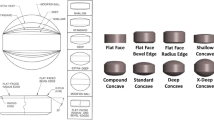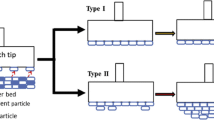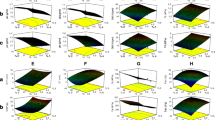Abstract
Capping is a common problem in the manufacture of some types of tablets and unless resolved, the tableting process cannot proceed. Hence, all factors that can help to lessen the likelihood of capping without unnecessarily reduce turret speed and/or compaction force would be tenable. This study investigated the influence of tablet punch configuration on mitigation of tablet capping. Tablets were prepared from high-dose paracetamol-potato starch granules in a rotary tablet press with flat face plain (FFP), flat face bevel edge (FFBE) and flat face radius edge (FFRE) punch configurations. The directly compressible (DC) fillers tested were microcrystalline cellulose (MCC), pre-gelatinised starch (PGS) and lactose. Design of experiments (DoE), a tool of quality by design (QbD) paradigm, was used and the interaction of input variables (compression force, tablet punch configuration and DC filler) affecting the response factors (tablet hardness and capping rating) were evaluated. FFP punches were able to mitigate capping best. FFRE punches showed more potential than FFBE punches at alleviating capping in a particular compression force range, without the limitations of the FFP punches that produce cylindrical tablets that were more friable. Incorporation of PGS in the tablet formulation was observed to be more efficient at mitigating capping than the other DC fillers when FFBE and FFRE punches were used. Overall, this study serves as a model for prospective product development based on the QbD framework and the optimal use of compaction tools.





Similar content being viewed by others
References
Desai PM, Liew CV, Heng PWS. Review of disintegrants and disintegration phenomena. J Pharm Sci. 2016;105:2545–55.
Aulton ME, Taylor K. Aulton’s pharmaceutics: the design and manufacture of medicines. 4th ed. Churchill Livingstone: Elsevier; 2013.
Carlin BAC. Direct compression and the role of fillers-binders. In: Augsburger LL, Hoag SW, editors. Pharmaceutical dosage forms: tablets. New York, London: Informa healthcare; 2008. p. 173–216.
Freeman T. Correlating die-filling performance with powder properties. Pharm Technol. 2011;35:s24–8.
Akseli I, Ladyzhynsky N, Katz J, He X. Development of predictive tools to assess capping tendency of tablet formulations. Powder Technol. 2013;236:139–48.
Anuar MS, Briscoe BJ. The elastic relaxation of starch tablets during ejection. Powder Technol. 2009;195:96–104.
Fassihi AR, Parker MS. Formulation effects on capping tendencies. Int J Pharm. 1986;31:271–3.
van der Voort MK, Zuurman K, Vromans H, Bolhuis GK, Lerk CF. Stress relaxation of compacts produced from viscoelastic materials. Int J Pharm. 1997;151:27–34.
Akseli I, Stecuła A, He X, Ladyzhynsky N. Quantitative correlation of the effect of process conditions on the capping tendencies of tablet formulations. J Pharm Sci. 2014;103:1652–63.
Garr JSM, Rubinstein MH. An investigation into the capping of paracetamol at increasing speeds of compression. Int J Pharm. 1991;72:117–22.
Desai PM, Van Vaerenbergh G, Holman J, Liew CV, Heng PWS. Continuous manufacturing: the future in pharmaceutical solid dosage form manufacturing. Pharmaceutical Bioprocessing. 2015;3:357–60.
Akande OF, Rubinstein MH, Rowe PH, Ford JL. Effect of compression speeds on the compaction properties of a 1:1 paracetamol-microcrystalline cellulose mixture prepared by single compression and by combinations of pre-compression and main-compression. Int J Pharm. 1997;157:127–36.
Wu CY, Hancock BC, Mills A, Bentham AC, Best SM, Elliott JA. Numerical and experimental investigation of capping mechanisms during pharmaceutical tablet compaction. Powder Technol. 2008;181:121–9.
Eiliazadeh B, Pitt K, Briscoe B. Effects of punch geometry on powder movement during pharmaceutical tabletting processes. Int J Solids Struct. 2004;41:5967–77.
Natoli D. Small changes to tablet shape bring big results. Int Pharm Ind. 2014;6:114–7.
Newton JM, Haririan I, Podczeck F. The influence of punch curvature on the mechanical properties of compacted powders. Powder Technol. 2000;107:79–83.
Alderborn G, Nystrom C. Radial and axial tensile strength and strength variability of paracetamol tablets. Acta Pharm Suecica. 1984;21:1–8.
Charoo NA, Shamsher AAA, Zidan AS, Rahman Z. Quality by design approach for formulation development: a case study of dispersible tablets. Int J Pharm. 2012;423:167–78.
Desai PM, Er PXH, Liew CV, Heng PWS. Functionality of disintegrants and their mixtures in enabling fast disintegration of tablets by a quality by design approach. AAPS PharmSciTech. 2014;15:1093–104.
Verma S, Lan Y, Gokhale R, Burgess DJ. Quality by design approach to understand the process of nanosuspension preparation. Int J Pharm. 2009;2009:377,185–98.
Sarkar S, Ooi SM, Liew CV, Heng PWS. Influence of rate of force application during compression on tablet capping. J Pharm Sci. 2015;104:1319–27.
Kadiri MS, Michrafy A. The effect of punch’s shape on die compaction of pharmaceutical powders. Powder Technol. 2013;239:467–77.
Krok A, Peciar M, Fekete R. Numerical investigation into the influence of the punch shape on the mechanical behavior of pharmaceutical powders during compaction. Particuology. 2014;16:116–31.
Acknowledgements
The authors would like to acknowledge the financial support from GEA-NUS PPRL fund (N-148-000-008-001) and A*STAR SERC grant no. 102 161 0049 (R-148-000-157-305).
Author information
Authors and Affiliations
Corresponding author
Ethics declarations
Conflict of interest
The authors declare that there are no conflicts of interest.
Rights and permissions
About this article
Cite this article
Desai, P.M., Anbalagan, P., Koh, C.J.N. et al. Evaluation of tablet punch configuration on mitigating capping by a quality by design approach. Drug Deliv. and Transl. Res. 8, 1635–1643 (2018). https://doi.org/10.1007/s13346-017-0425-0
Published:
Issue Date:
DOI: https://doi.org/10.1007/s13346-017-0425-0




